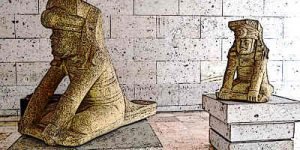Olmec were the oldest known civilization in the Mesoamerican region and believed by most researchers to be a precursor to the later Mayan civilization.
Although Mayans were known for their Long Count calendar, it is believed that this calendar was originally devised and developed by the Olmecs.
It is also believed that the Olmec had a concept of zero which was used in the creation of the Long Count calendar and was later borrowed by the Mayans.
Although the oldest Mesoamerican calendar artefact’s are dated to a period later than the end of the Olmecs, the location of these artefact’s is outsides the Mayan heartlands which reinforces the theory that they belong to the Olmec civilization.
Although no direct evidence exists, it is believed by most historical researchers that Olmec were among the first Mesoamerican people to develop a calendar of their own. This is substantiated by certain circumstantial evidence. For instance, Olmec were the first Mesoamerican people to give up a nomadic lifestyle and settle down for agriculture.
Consequently, they felt the need to be able to predict climate and developed astronomy. It was based on this knowledge of astronomy that the Olmec were probably able to create a calendar.
Significant evidence now exists to show that the mathematical system that was later used by the Mayans originated earlier and was probably invented by the Olmecs. This system comprised of dots and bars to denote different numerical figures.
The earliest evidence of the use of this system dates back to 31 B.C., being prevalent among the epi-Olmec peoples of the age. Since researchers believe that epi-Olmec was descended from the Olmec, at least in part, there is significant proof to suggest that they inherited the mathematical system from the Olmecs.
The presence of such mathematical system would seem logical in the presence of an Olmec culture which had knowledge of astronomy and which later went on to create a calendar system.
The most famous calendar created in Mesoamerica is usually associated with the Mayans. Mayans extensively used their calendar which comprised of three cycles, namely the solar cycle, the lunar cycle and the Long Count cycle.
As a civilization, Mayans had borrowed a large number of elements from the Olmec civilization, possibly including direct descendants.
Since the Olmec vanished nearly the same time that the Mayans rose in Mesoamerica, it is believed that the Olmec civilization was transformed by reaching a new homeland and by being adopted by a new people, namely the Mayans.
In this context, it is understandable that apart from other things that they adopted, Mayans also took up the Olmec calendar system. This is particularly plausible because Mayan cities also had an agrarian lifestyle and were in need of astronomy, mathematics and a calendar system much like the Olmecs.
No extant evidence directly provides proof of the presence of a calendar system in the Olmec civilization. However, indirect evidence substantiates this hypothesis.
Of particular interest is the critical link between Olmec and the Mayans – this is the epi-Olmec culture which rose in the city of Tres Zapotes after the Olmec civilization had declined.
The epi-Olmec culture borrowed many elements of the Olmec civilization. Of particular interest is the fact that it is the epi-Olmec culture which provides the earliest archaeological evidence of the use of a mathematical system and a calendar.
The mathematical system they used was the same which was later used by the Mayan civilization, so there is sufficient information to suggest that the epi-Olmec and the later Mayan civilization were closely linked.
It is quite possible that since the Mayans bloomed into a greater civilization, they eventually absorbed the epi-Olmec culture which had a decisive impact on the Mayan civilization.
Most ancient civilization usually came to the development of a mathematical system and calendar after they had developed a writing system of their own.
Until recently, it was believed that the Olmec didn’t have a writing system.
However, recent discoveries made by archaeologists in Mesoamerica have led to the recovery of certain stone tablets dating back to the Olmec period.
These tablets contain inscriptions which are regarded as a writing system unique to the Olmec civilization.
Although scholarly consensus on this is still lacking, it is accepted by many researchers that the Olmec had a writing system of their own. And in light of this, it is easier to establish that the Olmec could have evolved a writing system and calendar as well, using this writing system.
Another circumstantial evidence of a strong link between the Olmec and the Mayan civilizations is that of the continuity of the same deities.
The Olmec revered animals such as jaguars, snakes, sky-dragons, sharks and eagles. They believed that these animals were either a direct manifestation of the gods or that they were different Olmec rulers who had transformed into the animal form.
Some extant Olmec art figurines also depict individuals in the shape of part-human and part-animal.
It is interesting to note that many of these aspects of religion and Olmec cosmology didn’t end with the end of the Olmec civilization. Rather, they were taken up by the Mayan civilization and evolved into a new form, although greatly similar to the original Olmec belief system.
Based on this, it can be surmised that a central cultural object such as a calendar must also have been passed from the Olmec to the Mayans.

According to certain circumstantial evidence, it is believed that the Olmec had a calendar system which they evolved by using their knowledge of astronomy and their mathematical system. The closest evidence for this is found among the epi-Olmec peoples in the first century B.C., a time when the original Olmec civilization had already declined.
There is sufficient evidence to plausibly hypothesize that the later Mayan calendar system was greatly influenced by the Olmec culture and possibly influenced entirely from the Olmecs.